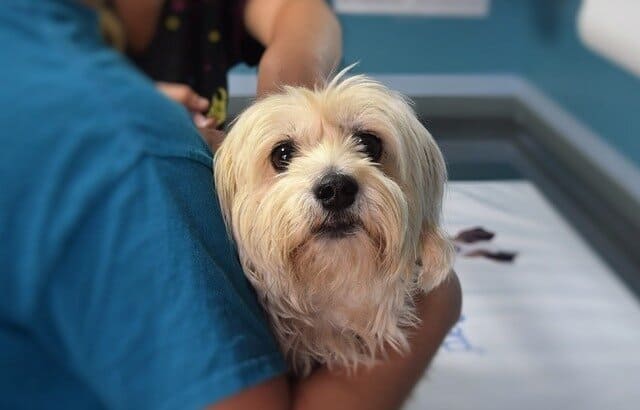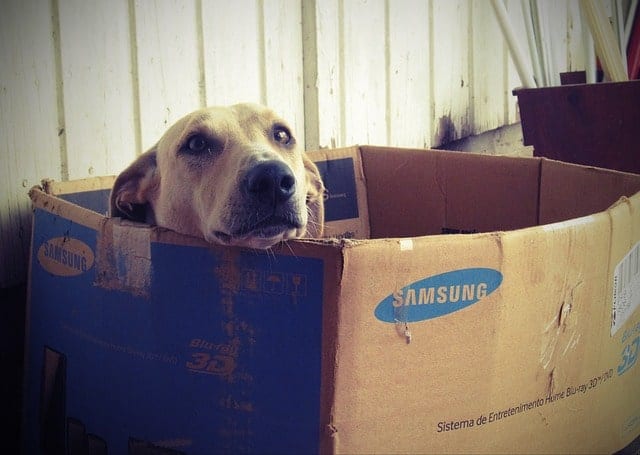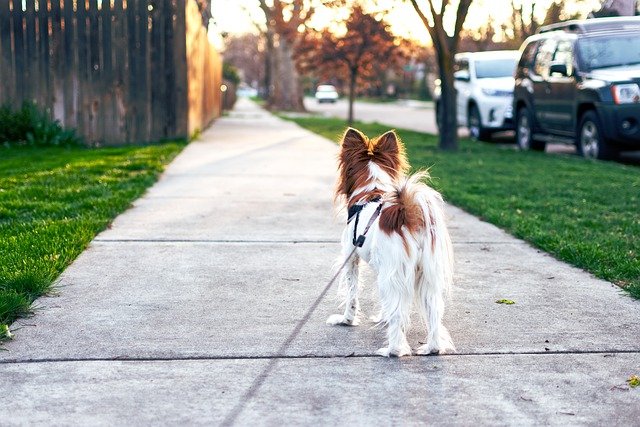Moving house is no one’s idea of fun. From packing to organizing movers, there’s certainly a lot to think about. And if you’re a dog owner? You’ll have even more to consider to ensure a successful move for both you and your dog.
So how can you help your dog move houses without a hitch? Below, I’ve shared my top 10 tips for moving with a dog.
1. Schedule a Visit to the Vet

Photo courtesy: Pixabay Public Domain
When you’re already overloaded with tasks preparing for your big move, taking your dog to the vet is probably the last thing on your mind. However, there are many reasons why a visit to the vet a few weeks before you leave is a good idea.
First, you’ll be able to obtain copies of important documents, such as your dog’s veterinary records and vaccination certificates, if you don’t have them already. This is particularly vital if you’ll be moving far away from your current vet.
While there, you can also ask your vet to give your dog a physical exam and to check that all of their preventive care is up to date. Your dog may need some additional vaccinations or parasite prevention based on changes to their lifestyle and disease prevalence at their new location. Crossing state lines can require a current certificate of veterinary inspection, which your vet can also provide. This table produced by the AVMA is a great source of information regarding state requirements for certificates of veterinary inspection.
Finally, going to the vet is worthwhile as you’ll be able to seek expert advice on how to make the move as stress-free as possible for your dog. If you’re concerned that your dog will have trouble coping with the move (which can be a big problem for dogs with anxiety, senior dogs, or those with health problems), your vet may be able to prescribe them a sedative or anti-anxiety medication.
2. Keep a Routine
Dogs are perceptive, so they can sense when something is amiss. As significant changes can make a dog feel anxious or stressed, it’s a good idea to stick to their regular routine as much as possible. While it won’t always be feasible to take them for a walk or feed them at the same time as usual, trying your hardest to do so will help ease your dog’s anxiety about the impending move.
3. Help Them to Desensitize to the Move

Photo courtesy: Pixabay Public Domain
One of the reasons keeping a routine is so important is that despite your efforts, a lot will be changing around them. It can be very unsettling for dogs to suddenly see lots of new objects, like piles of cardboard boxes, hear many new sounds, and be surrounded by unusual smells, so try to desensitize your dog to them before the move. This doesn’t need to be complicated—maybe pack a few boxes a week early and leave them out to help them get used to what’s to come.
If your dog already appears extremely anxious, you may want to consider taking them to a dog sitter while you pack.
4. Crate Train Your Dog Well in Advance
If your dog is already crate trained, more than half the battle is won. If they’re not, it’s time to get crate training. Leaving this as a last-minute task (or worse still, shoving your dog in a crate with no training) is unwise as the process can take days or even weeks.1 A comfortable crate will help keep your dog safe and relaxed throughout the move.
5. Familiarize Them With Your New Home

Photo courtesy: Pixabay Public Domain
If you live close to your destination, take your dog for a visit before your move. Letting your dog see and smell their new home and neighborhood will go a long way towards easing their anxiety when they move in.
6. Pack Their Belongings Last
Packing your dog’s belongings last will allow them to stick to their routine for as long as possible in the lead-up to the big move. While it may be troublesome to leave their belongings unpacked, your dog will thank you for it!
When the time comes to finally pack their belongings, make sure to pet them all in the clearly marked boxes. That way, you’ll be able to easily unpack your dog’s things as soon as you’re in your new home—and won’t need to waste time scrambling to find what they need.
7. Adequately Prepare for the Car Ride

Photo courtesy: Pixabay Public Domain
Don’t wait until the last minute to figure out the logistics of getting your dog safely from your old home to your new home. Spend time ensuring everything is organized, from how you’ll get them from point A to B, to what you’ll need to bring for them on the car ride.
Pack a small bag with their favorite toys and some treats to comfort them during the ride. If you need to drive for several hours, you’ll need to schedule water and potty breaks, too.
8. Update Your Dog’s ID Tag and Microchip
Dogs have been known to get lost in all the chaos associated with moving. Be sure to update your dog’s ID tags with your new address (and number if you’re switching to a new one) before your move, and don’t forget to update your contact information with the company that manages your dog’s microchip. Having your dog microchipped improves the chances they will be reunited with you if they ever get lost.2 Having both a visible ID tag and a microchip is the best way to ensure that your dog will be returned to you as quickly as possible.
9. Help Your Dog Settle In Straightaway

Image courtesy: Pixabay Public Domain
While you may find it easy to settle into your new home, the transition can be difficult for some dogs. Fortunately, there are numerous expert-approved ways that you can help your dog feel comfortable in their new home.3 You’ll no doubt have a million and one things to take care of, but make a conscious effort to give your dog plenty of love and attention to help them relax and adapt to their new home.
10. Double-Check Your Fences
If your new home has a fenced yard, congratulations! But don’t assume it will keep your dog safely on your property until you thoroughly inspect it and make any necessary repairs. For some dogs, a wireless dog fence can be a good option, particularly if your physical fence isn’t as sturdy or escape-proof as you’d like.
- The Humane Society of the United States. Crate training 101. Humanesociety.org. Accessed February 23, 2021.
- AVMA. Microchipping of Animals FAQ. Avma.org. Accessed February 23, 2021.
- The Humane Society of the United States. Bringing your new dog home. Humanesociety.org. Accessed February 23, 2021.














